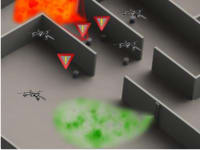The aim of this project is to support search and rescue missions with gesture controlled swarms of aerial and ground based robots. Search and rescue operations in scenarios such as earthquakes, gas leaks and fire outbreaks today face some major challenges, the biggest of them being the time taken by the human rescue team to search and locate victims in the damaged area. This is caused due to limited human visibility and limitations of other human sensory organs in such situations. Another issue that slows things down is the possibility of presence of dangerous environments (like gas leaks) which become a threat for the human rescue team. This becomes even more inefficient if the search environment is a big one, for example searching for a lost soldier in a dense mountainous forest. A swarm of UAVs and UGVs working together with the human rescue team can resolve most of these problems.
We aim to develop a search and rescue robot team which can function in an autonomous fashion once it has been issued a high level command. The primary function of the swarm is to search and locate victims in an earthquake/fire scenario and relay this information to its human controller. Another function that the swarm is responsible for is sensing its environment and reporting gas leaks and other dangers to the human operator. We are targeting high efficiency and speed to make sure that the robot involvement produces highly improved results.
What makes this more efficient is the presence of gesture based control. Unlike other controlling gear and mechanisms, gestures are intuitive. In emergency scenarios which all rescue missions are, gestures are the best way of communication. They do not require manipulating a device like a joystick, nor can they be distorted like voice commands. A fast, efficient, highly autonomous, gesture controlled robot swarm would go a long way in improving the current search and rescue teams and hence help save more lives.
Now , Unmanned aerial vehicles (UAVs) can be used to cover large areas searching for targets. However, sensors on UAVs are typically limited in their accuracy of localization of targets on the ground. On the other hand, unmanned ground vehicles (UGVs) can be deployed to accurately locate ground targets and detect humans,fire,gases etc., but they have the disadvantage of not being able to move rapidly or see through such obstacles as buildings or fences. Therefore we are aiming to exploit this synergy by creating a seamless network of UAVs and UGVs in order to make our rescue missions more efficient.
Most of the solutions in the market consist of a single robot only , but our model being composed of a whole swarm of UAVs and UGVs will help a lot in saving the precious lives of the people and also the lives of the defense personnel and rescue teams involved in these missions and and save a lot of time.
Like this entry?
-
About the Entrant
- Name:Sukrit Gupta
- Type of entry:teamTeam members:Sukrit Gupta
Utkarsh Rana
Krishika Shivnani
Anupam Adhikari
Rishabh Raghav - Software used for this entry:ROS , MATLAB , Gazibo , Python
- Patent status:none








